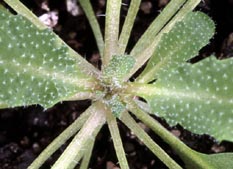Biologists finally close in on 'florigen,' the signal that causes plants to flower
By Sarah Nell Davidson

Postdoctoral researcher Brian Ayre was listening attentively to a Cornell University seminar on flower development when he asked what seemed an obvious question: "What is the signal that controls flowering?" The seminar speaker laughed. "They've been trying to figure that out for a hundred years," he said. More laughter followed, as one of Ayre's colleagues shouted from the back of the room: "Florigen!"
No one's laughing now. Ayre, currently a faculty member at the University of North Texas, went on to publish a provocative report in the August 2004 issue of Plant Physiology along with his postdoctoral adviser Robert Turgeon, a Cornell professor of plant biology. Their paper recounts the serendipitous discovery that the plant protein, CONSTANS, may be the signal -- "florigen" -- that causes plants to flower. Or at least, the researchers say, CONSTANS plays an important role in generating the signal.
Trying to understand flowering is a popular pursuit because of its importance in agriculture. Flowers are the precursor of fruit, and if flowering can be controlled, plants can be manipulated to remain in a vegetative or flowering state. Accelerated flowering could lead to a much shorter growing season -- an important advance for both growers and plant breeders. And the significance for the floriculture industry is equally huge.
Textbooks predating the 1970s dedicated entire chapters to this elusive signal. More recently, though, florigen has become an example of a dead-end pursuit in plant biology -- one more likely to prompt sarcastic grins than scientific inquiry to find this crucial puzzle piece in the understanding of plant development.
Turgeon's research focus at Cornell is on understanding how molecules move in the phloem, the "bloodstream" of plants that carries food, nutrients and signaling molecules. When Ayre joined his group, they were by no means setting out to discover the signal for flowering.
But as sometimes happens in science, "people from outside of the field end up making significant contributions because they have different tools and different perspectives," says Turgeon, picking up the story: "We were coming at the study from a transport perspective. We got into this when we got a hold of the promoter of the galactinol synthase gene, a genetic factor that drives expression of genes specifically in the vein of the leaf so that they can enter the phloem. I saw this as a tool to study the transport of large molecules through the phloem. Once we got the tool, we began to design experiments to use it. We applied it and got a very interesting result."
The researchers took two approaches that led them to the conclusion that CONSTANS is a signal involved in flowering. First, using Arabidopsis plants in which all CONSTANS protein had been abolished, they introduced a copy of the CONSTANS gene under the control of the galactinol synthase promoter, which causes the protein to be synthesized only in the leaf. Despite this precise expression pattern, they saw that the signal had a dramatic effect on flowering. This suggests that either CONSTANS is moved throughout the plant to the site of flowering through the phloem, or it interacts with another factor inside the phloem that is transported to the site of flowering.
They provided further evidence for CONSTANS' role in floral signaling when they grafted Arabidopsis plants that contained no CONSTANS protein onto plants synthesizing CONSTANS in their leaves. This elegant experiment showed that CONSTANS, or another factor that it interacts with, was able to move through the graft junction to signal flowering in the parts of the plant that formerly were devoid of any of the protein.
However, it is not clear whether CONSTANS is in fact the flowering hormone. More likely, Ayre says, "It may be interacting with another downstream factor that moves to the site of flowering action. It is clear now that CONSTANS is an important factor in generating this signal."
Comments Jan Zeevaart, an emeritus professor of plant biology at Michigan State University who has dedicated much of his research career to florigen and other plant hormones: "It is gratifying to see that there are finally molecular approaches to the problem. For quite some time, some people have ridiculed the concept of florigen, but those of us who have worked on the physiological aspects always knew that it could not be dismissed so easily."
The article in Plant Physiology was titled "Graft Transmission of a Floral Stimulant Derived from CONSTANS." Ayre's and Turgeon's work was supported by the U.S. Department of Agriculture and the National Science Foundation.
At Cornell, Peter Davies, a professor in the Department of Plant Biology since 1969, has spent his career working on other plant hormones. Excited by the finding, he recently recalled a quotation from a fellow plant physiologist in the 1970s: "Flowering is a religion based on the totally unfounded dogma of florigen."
As it turns out, the "religion" may be about to get some new followers.
Sarah Nell Davidson is a graduate student in plant biology and a science-writing intern at the Cornell News Service.
Media Contact
Get Cornell news delivered right to your inbox.
Subscribe